

| 1904 | Master Index | 1906 |
1905 Chronology of Aviation History
Major Aviation Events
1905's Players


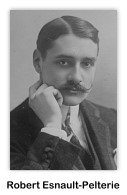




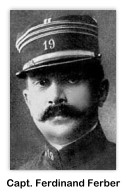
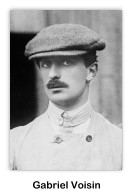
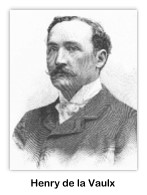
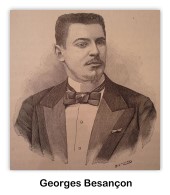

1905
1905 (Monaco) — The engineer Maurice Stanislas Lédger's helicopter lifts a person vertically into the air in Monaco. [3]
1905 (Omaha, Nebraska) — The U.S. Army Signal Corps transferred all balloon school activities to Fort Omaha, Nebraska. [3]
1905 (United States) — Lieutenant Frank P. Lahm becomes the first Army balloon pilot. [2]
January 1905
1 January 1905 (United States) — Eye-witness account of Wright flight. When the Wright Brothers made the first powered circular flight on 20 September last year, they had a witness, Amos Root, the editor of the journal Gleanings in Bee Culture. In today's edition, Root vividly describes what he saw in what is the first eye-witness account of a powered flight: “Imagine a locomotive that has left its track, and is climbing up in the sky towards you - a locomotive … with white wings,” he gushes. He declares that the invention may be one day “outrank … all other methods of travel.” [1]
5 January 1905 (Paris, France) — At a conference of Aéro-Club de France, pilot in designer Robert Esnault-Pelterie argues against the system of wing-warping. He says that it destroys the aerodynamics of the airplane. In its place, he presents a design he tested last year: a pattern of independent surfaces on the wing which can be maneuvered by the pilot. [1]
18 January 1905 (USA) — The Wright brothers began discussions with the United States Government about selling it an airplane. [2,3]
26 January 1905 (Washington, D.C.) — The U.S. Army Board of Ordnance and Fortification turns down the Wright brothers' offer to sell one of their machines to the Army. In a letter to Congress, the brothers argue that airplanes can carry out reconnaissance flights and transport messages. However, they offer no proof that their machines work. [1]
February 1905
1 February 1905 (Farnborough, England) — Samuel F. Cody begins a three-month contract as a kiting instructor at the British Army's Balloon Factory, a week after the government bought two sets of kites from him on January 25, one for observation and the other for transmitting signals. [1]
March 1905
16-20 March 1905 (Aptos, California) — Daniel Maloney is launched by balloon in a tandem-wing glider designed by John Montgomery and makes three successful flights at Aptos, California, the highest launch being at 3,000 feet with an 18 minute dissent to a predetermined landing location. [3]
26 March 1905 (Paris, France) — French flyers began searching for a more permanent airfield. Today saw the first flight at a new base for French aviators at Issy-les-Moulineaux, a suburb on the left bank of the Seine to the south-west of Paris. Finding an alternative to locations nearer the center has become a priority in the face of a growing concern at the dangers of flights over the city. Ernest Archdeacon, president of the Aéro-Club de France, and aviation enthusiast Henry Farman have been at the forefront of the search, which bore fruit on March 20 when Farman was given permission to use the army's parade ground at Issy. It is an ideal spot, away from the city but easily accessible by métro and near part of Paris's old fortifications, which provide an excellent grandstand for spectators. The army has allocated the airman special times for use of the ground. Unfortunately today's inaugural flight, by Archdeacon's second Wright-type glider, was not a process. The pilotless craft was towed aloft by a motorcar but crashed after part of the tail broke away. [1]
April 1905
27 April 1905 (Aldershot, England) — Under the supervision of Samuel F. Cody, Sapper Moreton of the British Army's Balloon Section reaches 2,600-ft beneath a man-carrying kite under the supervision of the kite's designer, Samuel Cody. [1,3]
29 April 1905 (Santa Clara, California) — Daniel Maloney is launched by balloon in a tandem-wing glider designed by John Montgomery to an altitude of 4,000-ft before release and gliding and then landing at a predetermined location as part of a large public demonstration of aerial flight at Santa Clara, California. This method of launching was first suggested by Sir George Cayley in 1852. [1,2,3]
May 1905
14 May 1905 (Saint-Cloud, Paris, France) — The Dufaux brothers from Geneva demonstrate a model helicopter. Powered by a 3-hp engine, and 37-lb machine succeeds in lifting a load of 13-lbs. [1]
25 May 1905 (Chalais-Meudon, France) — Ferdinand Ferber makes his first aerial test with his N° 6bis glider fitted with a 12-hp Peugeot motor. [1]
27 May 1905 (Chalais-Meudon, France) — Ferber seeks more powerful engine for his flying machine. Captain Ferdinand Ferber made a significant new move in his experiments today by fitting a 6-hp Peugeot engine to his N° 6 flying machine. It drives a single propeller just in front of the pilot's seat. The aircraft was launched by Ferber's ingenious system of cables to give it the impetus to take-off, but the flight itself was unremarkable. The angle of the glide was shallower than his unpowered flights, around 1 in 8, suggesting that the engine had some effect, although it was clearly not powerful enough to sustain N° 6 in horizontal flight.
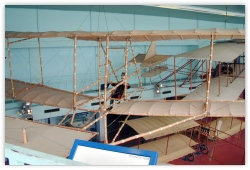 Ferber also found that the effect of the turning of the propeller made the aircraft turn towards the direction of its rotation, an effect caused by torque, making it difficult to control in the air. His airplane has no rear rudder or lateral control other than steering air brakes at the wing tips. He has now approached engineer Léon Levavasseur to build a 24-hp engine that will turn two propellers in opposite directions to neutralize the torque. The question is whether the famous engine designer could make an engine light enough to be carried by the aircraft.
Ferber's flight is significant because it represents the first time in Europe that a powered aircraft has been in free flight, although it might be more aptly described as “a powered glide”. [1]
Ferber also found that the effect of the turning of the propeller made the aircraft turn towards the direction of its rotation, an effect caused by torque, making it difficult to control in the air. His airplane has no rear rudder or lateral control other than steering air brakes at the wing tips. He has now approached engineer Léon Levavasseur to build a 24-hp engine that will turn two propellers in opposite directions to neutralize the torque. The question is whether the famous engine designer could make an engine light enough to be carried by the aircraft.
Ferber's flight is significant because it represents the first time in Europe that a powered aircraft has been in free flight, although it might be more aptly described as “a powered glide”. [1]
June 1905
June 1905 (Russia) — An Institute of aerodynamics opens at Koutchino. A rich man named Riabouchinsky has spent 100,000 rubles in building it on one of his properties. [1]
6 June 1905 (France) — Lewis Seguin founds the Gnome engine company. His aim is to expand the workshops of the existing Gennevilliers company, which makes the German Gnome motor-car engine. [1]
8 June 1905 (Paris, France) — Gabriel Voisin succeeds in lifting off from the river Seine, in his box-kite glider when towed by a motorboat. [1]
23 June 1905 (Simms Station, Ohio) — The Wright brothers began tests of their latest machine, the Flyer III, which they have built in just one month. It is the first fully controllable and practical version of the original 1903 Wright Flyer. [1,3]
July 1905
14 July 1905 (USA) — Orville Wright has a serious crash with the Wright Flyer III, upon which the Wright brothers radically alter the aircraft. The front rudder is mainly the culprit for the Flyer's, insistent pitching. [3]
18 July 1905 (San José, California) — American crashes. A perilous flying experiment ended in disaster as Daniel Maloney plummeted nearly 2,000 feet to his death before thousands of spectators at San José, California. The experiment consisted of launching a piloted glider from a balloon. This was Maloney's third such flight this year for amateur inventor and self-publicist “Professor” John Montgomery. All went well until one of the ropes holding the balloon broke part of the gliders tail. Tragically, Maloney did not realize this and released the glider, only to plunge out of control to the ground. [1,3]
18 July 1905 (Paris, France) — Voisin forced to take a dip in the Seine. The French aeronaut Gabriel Voisin has conducted two more flying tests with floating gliders. Two “hydrogliders” were made available to him, one by experimenter Louis Blériot, the other by Ernest Archdeacon of the Syndicat d'Aviation. Both were towed by the racing motorboat L'Antionette along an open part of the Seine river between the Billancourt and Sèvres bridges. Voisin made a brisk flight with the first glider and quickly rose to 16.5-ft before suddenly coming down when the boat stopped. The second glider, which was much lighter, became airborne as soon as the boat took up the strain on the tow rope. Unfortunately, it crashed almost at once. Voisin was unhurt. [1]
August 1905
5 August 1905 (USA) — Charles K. Hamilton begins series of kite flights, towed by cars and boats. [2]
5 August 1905 (Cardiff, Wales) — Nineteen-year old Welshman Ernest Willows makes the first flight of Willows No.1, a semi-rigid airship he had built. [3]
September 1905
September 1905 (USA) — The Wright brothers resume flight experiments with the re-designed Flyer III with performance of the airplane immediately in the positive. Smooth controlled flights lasting over 20 minutes now occur. [3]
October 1905
5 October 1905 (Simms Station, Ohio) — Wilbur flies. Orville and Wilbur Wright are making amazing progress in turning their flying machines into a practical means of transport. In the past month, they have made five flights, each longer than a last, and today Wilbur Wright flew the brothers' latest machine, Flyer III, for 38 minutes 23 seconds, covering over 24.2 miles. It is the Wright brothers' first flight of more than half an hour. The Flyer III has the same general arrangement as their earlier designs. The Wrights have retained the superb 15/16-hp engine used in their machine last year but have added new propellers. As in the previous designs, the pilot flies the machine from a prone position on the wing. Until these recent flights, the Wright brothers have linked their wing-warping system with cables to the rudders at the rear, but they found that this caused the wings to slow up and lose lift on the inside of the turn. Now they have disconnected the two sets of controls, and they can put down the nose to increase speed while turning. The prolonged flights that they are now able to make enabled him to make dozens of turns at both ends of their test site at Simms Station, near Dayton. They now consider themselves complete masters of the new machine. Throughout the year the Wright brothers have been trying to interest the military authorities in the United States and England in their flying machines for use as a scouting aircraft. So far they have not had much luck, but the success of the 37-mph Flyer III will encourage them to try again. [1,3]
14 October 1905 (Paris, France) — International body for flyers set up. Delegates attending the current aeronautical conference in the French capital have given the go-ahead for a new international body to monitor and regulate developments in aviation. The organization is to be known as the Fédération Aéronautique Internationale [International Aeronautical Federation], or FAI. Pioneer aeronaut Count Henri La Vaulx can claim most of the credit for bringing the FAI into existence. Along with others involved in aviation, he has seen the need for some time for a universally recognized body to impose uniform standards and regulations on the proliferating number of aviators and flying clubs throughout Europe and the United States. The aims of the FAI were outlined during the Olympic Congress in Brussels in June, which called for the establishment of “a universal aeronautical federation to regulate the various aviation meetings, and to advance the science and sport of aeronautics". The founding nations are Belgium, Britain, France, Germany, Italy, Spain, Switzerland and the United States. [1,3]
16 October 1905 (Huffman Prairie, Ohio) — The Wright Brothers complete their 1905 test flight program, making their last flight until May 1908. [3]
November 1905
17 November 1905 (Dayton, Ohio) — The Wrights brothers write to Georges Besançon, the secretary-general of the Aéro-Club de France, giving a full account of their experiments with their Flyer III. [1]
28 November 1905 (Dayton, Ohio) — Wilbur and Orville Wright, write to the French ambassador in Washington, offering their airplane for sale to the French government as “a secret practical invention” and recommending that France send an attaché to Dayton to investigate. [1]
30 November 1905 (Lake Constance, Germany) — At Lake Constance, Count Ferdinand von Zeppelin's LZ2 airship is damaged significantly while attempting its first launch. [1,3]
30 November 1905 (New York City, New York) — Aero Club founded in the United States. A new American association reflecting the current renewed interest in the science of aeronautics has been established in New York City. Named the Aero Club of America, it will promote the enjoyment of ballooning as a recreation, much favored by Europeans for some years already. An exhibition of the sport is to be staged in January next year with “aerostats" (lighter-than-air craft) imported from Paris. It is hoped that this will fire the imagination of potential club pilots. The club aims plans to buy two balloons for hire by members. As New York has proved a poor center for active ballooning, being close to the sea and densely built up. Ascents are made from a field in Pittsfield, Massachusetts, were a good supply of coal gas is also available. [1]
30 November 1905 (France) — The Wright brothers' letter to Georges Besançon is published. [1]
December 1905
December 1905 (Nova Scotia, Canada) — Neil MacDermid is carried aloft in Canada by a large box kite named The Siamese Twins, designed by Alexander Graham Bell. [1,3]
5 December 1905 (Washington, D.C.) — Colonel H.J. Foster, the British military attaché in Washington, breaks off negotiations with the Wright brothers for the purchase of one of their machines. The War Office has asked for an advance demonstration, but the Wright brothers are unwilling to show the aircraft without a guaranteed deal. [1]
24 December 1905 (Paris, France) — Wright brothers' claim still doubted in France. There were explosive scenes at the meeting of the aviation committee of the Aéro-Club de France yesterday when the truth about the claims of the Wright brothers to have mastered powered flight were challenged again. This follows the publication on November 30 of a letter from the Wrights to Georges Besançon, secretary-general of the Aéro-Club de France, describing flights of up to 38 minutes near Dayton this fall. The reports of several witnesses have been verified by French journalists, yet one group within the Aéro-Club de France, foremost among them Ernest Archdeacon, firmly refuses to believe them. The controversy is likely to continue for as long as the Wrights refused to fly their machine in public, for fear that their methods of construction would be revealed to competitors. [1]
28 December 1905 (Canada) — Doctor Alexander Graham Bell's box-kite, The Siamese Twins, lifts off carrying pilot Neil MacDermid. It is made of 1,829 cells, each 10 inches wide. [1]
Works Cited
- Gunston, Bill, et al. Chronicle of Aviation. Liberty, Missouri: JL Publishing Inc., 1992. 14-17
- Parrish, Wayne W. (Publisher). "United States Chronology". 1962 Aerospace Yearbook, Forty-Third Annual Edition. Washington, DC: American Aviation Publications, Inc., 1962, 446-469.
- Wikipedia, 1905 in aviation
- Shupek, John (photos and card images), The Skytamer Archive. Skytamer.com, Whittier, CA
Copyright © 1998-2018 (Our 20th Year) Skytamer Images, Whittier, California
ALL RIGHTS RESERVED


























